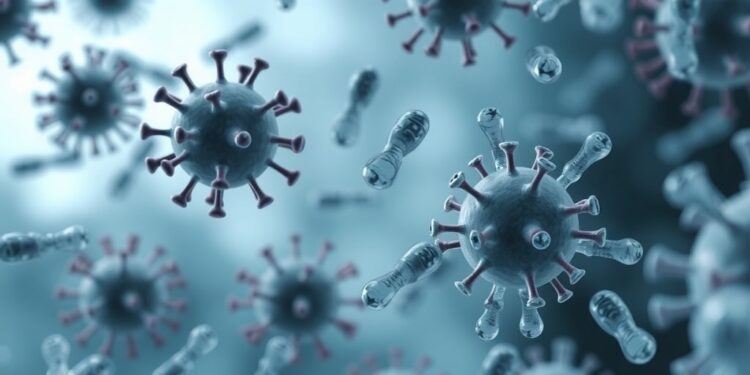
A groundbreaking new study from researchers at Indiana University Bloomington has provided a novel insight into the fierce microbial battle for dominance in complex ecosystems. The research, which focuses on the interaction between two specific bacteria, sheds light on how species can utilize viruses as tools to enhance their competitive edge. This newly discovered mechanism not only highlights the sophistication of microbial interactions but also opens potential pathways for harnessing these findings in tackling antibiotic-resistant bacterial infections, a growing concern in modern medicine.
The study, titled “Streptomyces secretes a siderophore that sensitizes competitor bacteria to phage infection,” was published on January 8, 2024, in the prestigious journal Nature Microbiology. Co-authored by notable figures from the Indiana University Chemistry and Biology departments, this work has generated significant interest in both the microbiological and medical research communities. PhD candidate Zhiyu Zang led the research efforts under the guidance of J.P. Gerdt, an assistant professor of chemistry, marking a significant contribution to our understanding of bacterial competition.
Traditionally, it has been established that bacteria engage in a complex form of warfare through the production of antibiotics. By synthesizing these chemical agents, bacteria can suppress rival species, securing essential nutrients and physical space. However, the IU Bloomington team’s findings reveal a far more intricately woven narrative, in which bacteria not only produce toxic compounds but also manipulate their competitors’ defenses. This raises intriguing questions about the evolutionary strategies bacteria develop not just to survive, but to dominate their microbial environments.
Central to the study is the interaction between the soil-dwelling bacteria Streptomyces and Bacillus subtilis. Both species are well known for their ecological roles, yet they embody a fierce rivalry in their natural habitats. Under experimental conditions that closely mimic their native environment, researchers documented that Streptomyces releases a metabolite called coelechelin, which effectively deprives Bacillus subtilis of iron, a critical resource needed for its defense against viral invaders.
Iron plays a crucial role in bacterial metabolism and is essential for various cellular processes. As Bacillus subtilis is stripped of its iron reserves, its resilience against bacteriophages—viruses that specifically infect bacteria—diminishes substantially. This vulnerability presents a unique opportunity for the Streptomyces species, which capitalizes on the weakened state of its competitor to establish a stronger foothold in their shared environment. Such intricate interactions highlight the delicate balance of microbial ecosystems and the unforeseen strategies involved in survival.
This research not only expands our understanding of bacterial interactions but also emphasizes the importance of environmental chemistry in microbial relationships. Gerdt points out that the metabolites secreted by one species can radically alter the competitive landscape and influence how effectively neighboring organisms can defend themselves. This insight could forge new avenues for therapeutic strategies that complement existing antibiotics, especially in an era where multidrug-resistant infections pose a significant threat to public health.
Moreover, the study hints at a collaborative aspect of microbial competition, suggesting that bacterial communities may engage in a form of chemical warfare that promotes a balance between cooperation and competition for resources. This dynamic interplay could have broader implications for our understanding of microbial ecology and the development of innovative biotechnological applications.
As researchers continue to explore these complex interactions, there is potential to apply this newfound knowledge in the fight against antibiotic-resistant infections. The combination of phages and targeted metabolites could create novel therapies capable of dismantling harmful bacterial populations without further contributing to resistance, thereby revolutionizing our approach to infectious diseases.
The research team envisions that the principles derived from their findings might inspire future studies aimed at unraveling the mechanisms of microbial interactions in greater detail. There is also significant interest in exploring how these dynamics can be leveraged in agricultural settings, where promoting beneficial bacterial communities could lead to healthier crops and sustainable practices.
A closer examination of the methodologies employed in the study reveals a rigorous experimental design that emphasized the importance of mimicking natural conditions. By carefully crafting an environment conducive to observing bacterial competition and viral infection, the researchers ensured that their findings were both relevant and translatable to real-world scenarios.
In summary, this study offers profound insights into the microbial world, demonstrating that the battle for survival is influenced not only by direct competition but also by complex chemical interactions that govern these relationships. The findings illuminate the delicate dependencies that exist within microbial ecosystems and the innovative strategies that species like Streptomyces employ to gain an upper hand.
This research underscores the critical importance of continued investigation into microbial interactions, not just to solve existing health challenges but also to enhance our understanding of ecological dynamics at a larger scale. By expanding the frontiers of microbial research, we can unlock new strategies for managing health and ecological sustainability in an increasingly complex world.
The implications of this work stretch far beyond the laboratory setting, potentially paving the way for advanced medical treatments and improved agricultural practices. As our understanding of these microbial interactions deepens, we may find ourselves better equipped to confront the challenges posed by bacterial diseases and the sustainability of our agricultural systems.
Collaboration among researchers from diverse fields will prove vital in unlocking further secrets of microbial behavior. Scientists must continue to engage in interdisciplinary partnerships to explore the vast complexities of bacterial life. Ultimately, the synergy between chemistry, biology, and ecological studies will be crucial in tailoring future research efforts aimed at harnessing the power of these tiny organisms.
By identifying how microbial communities interact through chemical signaling and viral exploitation, this research unveils a promising frontier in both microbiology and medicine that could meet the needs of our ever-evolving challenges.
—
Subject of Research: Bacterial competition and phage interactions
Article Title: Streptomyces secretes a siderophore that sensitizes competitor bacteria to phage infection
News Publication Date: January 8, 2024
Web References: https://www.nature.com/articles/s41564-024-01910-8
References: Not provided
Image Credits: Not provided
Keywords
Molecular chemistry, Soil bacteria, Species competition, Bacterial infections, Viral infections, Discovery research, Bacteriophages, Metabolites.





